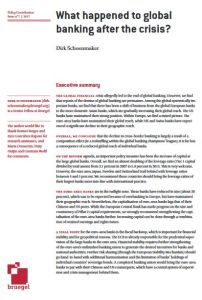Join getAbstract to access the summary!

Join getAbstract to access the summary!
Dirk Schoenmaker
What happened to global banking after the crisis?
Bruegel, 2017
What's inside?
The global banking ecosystem may not have retrenched as much as some believe.
Recommendation
In the years following the 2008 financial crisis, pundits and policy analysts decried the implosion of the global banking sector. But a fresh look at the international footprint of the largest global systemically important banks (G-SIBs) reveals a more nuanced picture of the current banking architecture. Professor Dirk Schoenmaker dissects the latest data and provides analysis on the influence, scale, scope and state of the G-SIBs from a global perspective. getAbstract recommends this detailed and expert report to banking professionals and those interested in assessing the condition of global financial institutions.
Summary
About the Author
Dirk Schoenmaker is a senior fellow at Bruegel.























Comment on this summary